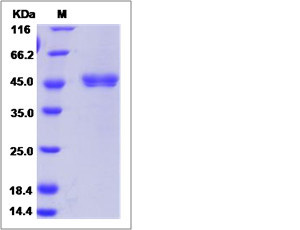| Catalog Number |
P81240-R08H |
| Organism Species |
Rat |
| Host |
Human Cells |
| Synonyms |
Cathepsin E, CTSE |
| Molecular Weight |
The recombinant rat Ctse consists 388 amino acids and predicts a molecular mass of 42.1 kDa. |
| predicted N |
Val 22 |
| SDS-PAGE |
 |
| Purity |
> 90 % as determined by SDS-PAGE. |
| Protein Construction |
A DNA sequence encoding the rat Ctse (AAH62002.1) (Met1-Pro398) was expressed with a polyhistidine tag at the C-terminus. |
| Bio-activity |
|
| Research Area |
Immunology |Inflammation / Inflammatory Mediator |Lysosomal Enzymes |
| Formulation |
Lyophilized from sterile 1 |
| Background |
Cathepsin E Protein (CTSE Protein) is a member of the peptidase C1 family that is a gastric aspartic protease that functions as a disulfide-linked homodimer. Cathepsin E Protein (CTSE Protein) is predominantly present in the cells of immune system and is frequently implicated in antigen processing via the MHC classⅡ pathway which however does not appear to be involved in the digestion of dietary protein. The protein has a specificity similar to that of pepsin and pepsin. Cathepsin E Protein (CTSE Protein) is found in highest concentration in the surface of epithelial mucus-producing cells of the stomach and also been found in more than half of the gastric cancers. It appears, therefore, to be an oncofetal antigen. |
| Reference |
Zaidi N, et al. (2008) Emerging functional foles of cathepsin E. Biochem Biophys Res Commun. 377(2) : 327-30.Zaidi N, et al. (2008) Cathepsin E: a mini review. Biochem Biophys Res Commun. 367(3) :517-22.Azuma T, et al. (1989) Human gastric cathepsin E Predicted sequence, localization to chromosome 1, and sequence homology with other aspartic proteinases.The journal of biological chemistry. 264: 16748-53. |

